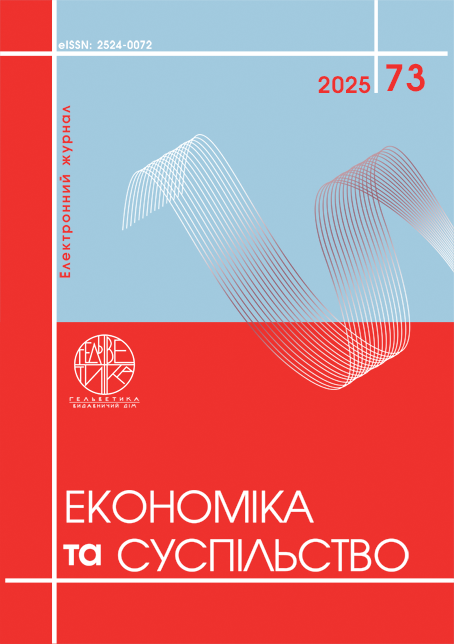MANAGEMENT OF THE PERSONNEL SOCIAL MOBILITY IN WAR CONDITIONS
Abstract
The article studies the features of managing personnel social mobility in wartime. It is determined that in wartime conditions the concept of personnel social mobility acquires additional meaning, including forced job changes, relocation, retraining, as well as flexible response to personnel losses and instability. Such mobility becomes not only a means of professional growth, but also a necessary tool for the survival of the enterprise, the preservation of human capital and ensuring the continuity of business processes. A mechanism for managing personnel social mobility is proposed, the implementation of which allows the organization to optimize personnel processes, form a personnel reserve, increase the level of employee motivation and prevent professional burnout. In wartime, the importance of this mechanism increases, as organizations face new challenges - employee migration, mobilization, business relocation, psychological pressure and personnel losses. A comprehensive approach to managing personnel social mobility involves the use of regulatory, social, behavioral, administrative and other methods. An important role in this process is played by human, financial, material, information and organizational resources, which ensure the effective implementation of measures for personnel mobility. The implementation of a systemic mobility management mechanism allows enterprises to effectively respond to the challenges of the modern labor market, adapt to changes, and remain competitive. The results of implementing a mechanism for managing personnel social mobility include reducing staff turnover, improving the social climate in the team, increasing employee satisfaction and their involvement in corporate processes. At the same time, the organization gets the opportunity to effectively adapt to changes in the external environment, which contributes to its long-term stability. The use of modern HR technologies and monitoring methods allows you to increase the effectiveness of social mobility management and create conditions for the professional development of personnel.
References
Біль М. Просторова мобільність населення: теорія, методологія, практика: монографія. Львів: ПАІС, 2018. 392 с.
Волошина С. В., Штик Ю.В. Сучасні тенденції мобільності персоналу на ринку праці. Соціально-економічні проблеми світового та національного господарства. Торгівля і ринок України. 2018. № 2(44). С. 35–42.
Hout M. Social Mobility. The Poverty and Inequality Report. 2019. P. 29–33.
Кир’янова О. В. Формування адаптаційної мобільності фахівця як чинник особистісної ефективності. Соціально-трудові відносини: теорія та практика. 2014. № 1. С. 290–295.
Лібанова Е. М. Зовнішні трудові міграції українців: масштаби, причини, наслідки. Демографія та соціальна економіка. 2018. № 2 (33). С. 11–26.
Мобільність робочої сили України: тенденції та перспективи: колективна монографія / за наук. ред. д.е.н., проф. І.Л. Петрової, д.е.н. В.В. Близнюк; НАН України, ДУ «Ін-т екон. та прогнозув. НАН України». К., 2023. 334 с.
Torche F. Intergenerational Mobility and Equality of Opportunity. Intergenerational Mobility and Equality of Opportunity. 2015. № 56(3). Р. 343–371.
Chetty R. Mobility Report Cards: The Role of Colleges in Intergenerational Mobility. National Bureau of Economic Research. 2017. URL: https://www.nber.org/papers/w23618.
Bil M.M. (2018). Prostorova mobilnist naselennia: teoriia, metodolohiia, praktyka [Spatial mobility of the population: theory, methodology, practice]. Lviv: PAIS. 392 р. (in Ukrainian)
Voloshyna S.V., Shtyk Yu.V. (2018). Suchasni tendentsii mobilnosti personalu na rynku pratsi [Modern tendencies of personnel mobility in the labour market]. Sotsialno-ekonomichni problemy svitovoho ta natsionalnoho hospodarstva. Torhivlia i rynok Ukrainy, no. 2(44), рр. 35-42 (in Ukrainian)
Hout M. (2019). Social Mobility. The Poverty and Inequality Report, pp. 29-33 (in English)
Kyrianova O. (2014). Formation of specialist’s adaptive mobility as a factor of personal effectiveness [Formuvannia adaptatsiinoi mobilnosti fakhivtsia yak chynnyk osobystisnoi efektyvnosti]. Sotsialno-trudovi vidnosyny: teoriia ta praktyka, no. 1, pp. 290-295 (in Ukrainian)
Libanova E. (2018). External labour migration of Ukrainians: Scale, causes, consequences [Zovnishni trudovi mihratsii ukraintsiv: masshtaby, prychyny, naslidky]. Demohrafiia ta sotsialna ekonomika, no. (2), рр. 11–26 (in Ukrainian)
Petrova I.L., Blyzniuk V.V. (eds.) (2023). Mobilnist robochoi syly Ukrainy: tendentsii ta perspektyvy [Labour mobility in Ukraine: trends and prospects]. Kyiv: Institute for Economics and Forecasting of the NASU, 334 р. (in Ukrainian)
Torche F. (2015). Intergenerational mobility and equality of opportunity. European Journal of Sociology, no. 56(3), pp. 343–371. (in English)
Chetty R. (2017). Mobility Report Cards: The Role of Colleges in Intergenerational Mobility. National Bureau of Economic Research. Available at: https://www.nber.org/papers/w23618 (in English)

This work is licensed under a Creative Commons Attribution 4.0 International License.


